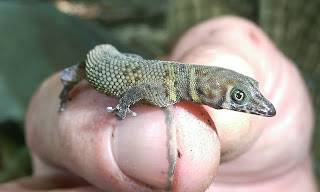
That is a quote from my collaborator Ignacio when he measured the levels of stress hormone in the blood samples we brought back from Hog Island boa constrictors last year. They had such low levels that many were virtually non-detectable. If you have ever spent much time on a Caribbean island, you might have low stress hormone levels, too. My lab group ventured to Honduras last week to further study this phenomenon in island boas.
Arriving in La Ceiba, bodies and luggage intact (rather a feat in itself, considering my previous experiences traveling to this particular place, which you can read about here and here):

And then it was off to Cayo Cochino Menor via boat:

As my senior colleagues told me recently while I was preparing my tenure packet, "We really just want to see what you did, don't give us too much commentary." In other words, I talk too much. I'll take that advice here, too.
I will present photos in the following order: a tour of Cayo Menor, its herps, our boa work, then invertebrates, then the three S's: snorkeling, scenery, and screwing around.
A TOUR OF CAYO COCHINO MENOR:

A view of Cayo Cochino Mayor (the other Hog Island) from our island (Menor), with some amazing reef in between:

Our island to the left, Cayo Culebra off the coast of Menor to the right, with the mainland mountains in the background:

The "lagoon," a wet area teeming with boas and invertebrates:
The "lion's head," a small projection at the north end of the island:

HERPS:
Even though we spent most of our time searching for boas as part of our study, the other herps on the island were constantly throwing themselves at us, requiring investigation. Here are the common ones:
Mexican Treefrog (Smilisca baudinii):

Honduran Spiny-tailed iguana (Ctenosaura melanosterna):

They sleep inside stumps and logs at night:

Green iguanas (Iguana iguana), on the other hand, sleep in trees at night, making them accessible to curious students :


A lemur anole (Norops lemurinus) sleeping on a leaf at night:

An Allison's anole (Anolis allisoni) at the restaurant (don't worry, that's not lizard meat in the soup. I'm not sure what it was, but it was mammalian):

Geckos fighting over territories at the restaurant:

A heretofore undiscovered species of gecko on the island (Gonatodes? sp.):

A rather cute little forest racer (Dryadophis melanolomus):

An adult black-striped snake (Coniophanes imperialis):
We captured and processed almost 150 boas in five days. Not too shabby. Results are forthcoming, of course, but for now here are some photos of us hard at work (honestly felt like hardly working).
Here is some typical boa habitat in the forest:

A boa in foraging posture. They blend right in with the branches, and when a bird or iguana is unlucky enough to choose the same branch, pow!

This apparently goes for bats, too, as this boa showed its appreciation for being captured by puking up a leaf-nosed bat:

When we captured a snake, we got a blood sample right away:

Then we took other data, like weighing the snake (there is a balance under this plate):

Lots of boas had ticks on them, especially on scars. These ticks are Amblyomma dissimile adults:
Then the boas were returned to their place of capture, and we went searching for more! Along the way, we encountered many cool invertebrates.
INVERTEBRATES:
The invertebrates on the island are absolutely amazing. During the day, you mainly see hermit crabs:

Some take advantage of the sea garbage to find new homes:

There are also gigantic tarantulas out day and night. Here's one eating a cockroach (that Matt fed to it):

Here's one that found its hairy way onto my hat.

A giant scorpion eating a cockroach:

This is another species of cockroach that is just huge:

A tailless whip scorpion (also giant, are you seeing a theme emerge here?):

And crabs are perhaps the most populous denizens of the forest at night, clicking around and scavenging like Garthim from the Dark Crystal:

The island is covered in HUGE termite mounds:

A very cool yellow fungus (Yes, fungi aren't inverts, but this didn't fit anywhere else):

SNORKELING, ETC.
When all the research was done and there was a day to spare, we hit the water. Okay, so some of the students did this every day on breaks. Wouldn't you?
Here's Amber and I next to the pier (which was guarded underneath by a barracuda):

Nick and I chilling in some crystal clear water:

The boys sneaking in a quick snorkel before dinner:

An incredibly cute little octopus hiding in a coral:

Lion fish are invasive predators here. Scott took a late night swim to spear a bigun':

Jess is a visiting scientist from Australia in charge of removing as many lion fish as possible. Here she is cutting out the stomach of Scott's fish to see if it had recently been sampling tasty native fishys:

Our awesome cook Marina fried up one of Jess's spoils, all one square inch of it:

Some serious RnR was had by all. Chilling on the pier:
Some late-night dominos:

I tried to teach the group some yoga poses, with a Cayos flare, of course. Here are some of our asanas:
Boasana:
Green Iguanasana:

Here's Tony practicing Cervezasana. I think that this was the most practiced pose of the trip.

Overall, it was an amazing trip. Good research, good weather, good company, great experience for all. With some wicked Central American sunsets.








